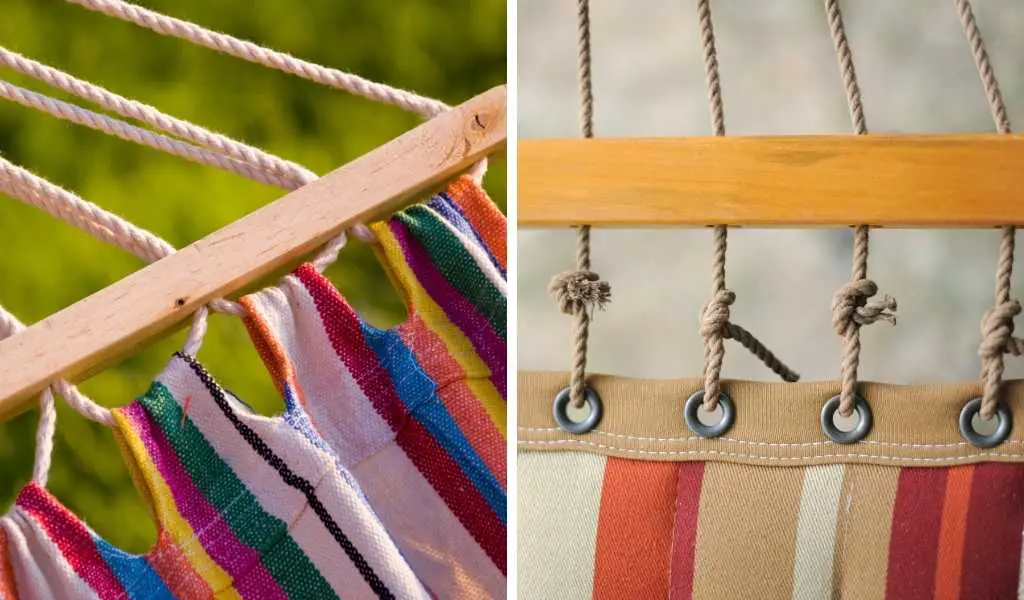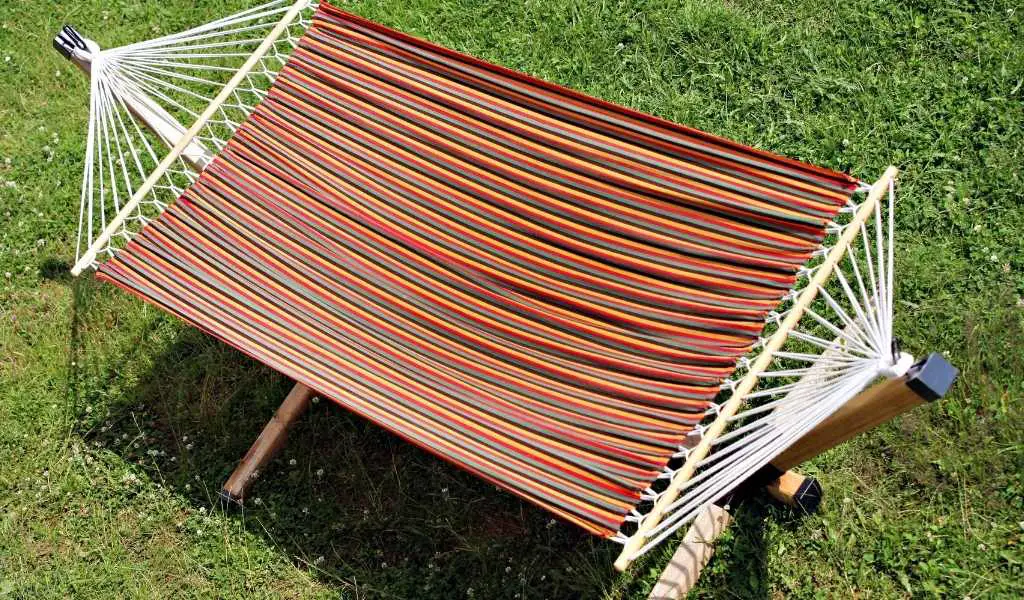Disclaimer: As an affiliate I may earn a commission on any qualifying purchases, including those from Amazon.com, at no extra cost to you – read more.
To spreader bar or not to spreader bar? That is the question of our day.
The spreader bar wasn’t part of the original hammock design back when it was created in South America. This was a feature added later on in a move to make it more like a bed.
Given the popularity of spreader bars in hammocks, it must mean that spreader bar hammocks are better, right?
Well, no, they are not better. The benefit of a spreader bar hammock is that they can be easier to get in to and give you an unobstructed view of your surroundings. However, there are downsides, such as being prone to tipping and providing less support for your body.
Personally, I dislike how tippy they can be with a spreader bar and prefer to be cocooned inside a Brazilian gathered-end hammock. But, there are plenty who feel the opposite way.
At the end of the day, it’s down to personal preference and the situations you’ll be using it. In the rest of this article, I’ll give you the full low down on whether spreader bars are right for you.
What is a Spreader Bar?
A spreader bar is the bar that runs across the top and bottom of the hammock, distributing the suspension strings evenly and giving the hammock a flatter and more open lay. It usually has holes drilled directly through it, the hammock strings are passed through and either a knot is tied or the string is passed back through another hole to keep it in place.
Spreader bars were not part of the original hammock design used in South America. For many centuries, hammocks were used for sleeping in at night without spreader bars, and even when the Navy adopted them for sailors on board their ships, they stuck to the original design, albeit using slightly different materials.
However, it is thought that the spreader bar was added to make them look more like a bed to entice western countries to give them a try. This seemed to work and saw hammocks garner popularity in the 19th and 20th centuries.
The first type of hammock to feature a spreader bar was the Nicaraguan hammock, this became popular in North America and is rarely referred to as a Nicaraguan hammock any more.
Which Hammocks Have Spreader Bars?
Here are the main types of hammock that feature a spreader bar:
Nicaraguan Hammock – The Nicaraguan hammock is thought of as the original spreader bar hammock and is the only South American hammock that is often found with spreader bars (although often without as well). This is the style that became popularised in North America so is often also referred to as an American hammock. These are usually made from woven cotton fabric and feature lavish designs, patterns and tassels.
Quilted Hammock – This hammock is similar in design to the Nicaraguan style, but rather than a woven fabric, it utilises two pieces of materials that have been sewn together, often with some sort of padding in between. They are notable for being extremely flat and are usually made from polyester which makes them durable and more weather resistant than cotton. A quilted hammock attaches to the spreader bar in a different way than a Nicaraguan hammock as shown in this image.

Rope Hammock – Rather than using a piece of material, rope hammocks are usually made from cotton or polyester ropes in an open weave. These hammocks originated without a spreader bar, but nowadays you will frequently find them with wooden spreader bars included.
Bridge Hammock – These types of hammock have a different design that has been created like a bridge. The crevice of the hammock runs parallel with the ground, which allows the occupant to lay completely flat. Then the sides of the hammock curl up around the occupant preventing the hammock from tipping. The bridge hammock does not have traditional suspension strips so the job of the spreader bar is to keep the hammock open. These are mainly used for camping and outdoors.
What are Spreader Bars Made From?
Spreader bars will typically be made from wood. These are easy to make and provide that classic hammock look and feel. A wooden spreader bar is usually straight, but there are also examples of curved wooden spreader bars which provide a little extra side support to help with the tipping issue.
The wood will usually be treated to provide protection against the elements but still shouldn’t be left out under extreme conditions. It’s recommended to occasionally re-treat the wood, using a sealer or varnish to extend it’s life.
For camping and outdoors, spreader bars are sometimes made of aluminium, or even plastic. These materials are much easier to care for than wood as they don’t absorb water and can be dried easily. They are more lightweight than wood and usually have a design that can be taken apart in a similar way to tent poles to make them more portable.
Spreader Bar vs Non-Spreader Bar Hammocks
To give an even argument, I’ve compiled all of the benefits that are associated with each type of hammock so that you can make your own decision.
The benefits of a spreader bar are:
- A spreader bar holds the hammock open, those who are new to hammocking may find this easier to get in and out of, although the jury is out on this one.
- You get a better view of your surroundings compared to a gathered end hammock where the sides can swallow you up and obstruct your sight.
- A spreader bar gives a flatter lay no matter which angle you position yourself, this makes it easier for side sleepers to get comfortable.
However, the benefits of a non-spreader bar hammocks are:
- Non-spreader bar hammocks have more sag and a lower centre of gravity, this makes them more stable and less prone to tipping.
- Not having a spreader bar makes the hammock far easier to fold away in to a small compact bag as there are no wooden or metal bars to worry about. This weight and space saving is particularly important for hikers and backpackers.
- A non-spreader bar hammock is better for back sleepers, especially if you’re lying correctly which is diagonally across the hammock, not in line with the crevice.
- Many professionals will tell you that a non-spreader bar hammock provides better support for your body because the hammock is free to mould to your shape. This is particularly true of cotton hammocks which have an extra stretchiness to them
As you can see, there are benefits to both options, but my firm favourite is the non-spreader bar.

Can You Add a Spreader Bar to a Hammock?
Spreader bars cannot easily be added to shop-bought non-spreader bar hammocks and it’s not something that I would recommend you attempt. For starters, every hammock is different so you would struggle to find a spreader bar to fit.
Even if you did manage to craft your own spreader bar that’s the perfect width with the correct number of holes for your suspension strings, they are usually made in the gathered-end style so it’s unlikely that you’d be able to remove and reattach the strings with enough strength to provide long term stability.
Of course, if you’ve made your own hammock then it could be a different story, especially if you’ve used the channel-end style that is common with DIY hammocks.
Final Thoughts
As you can see, there are pros and cons to the spreader bar. Personally, I prefer a non-spreader bar hammock and most frequent hammock dwellers would probably agree. However, for those who take a more casual approach to hammocking (or those with kids), there are some benefits to having a spreader bar.


